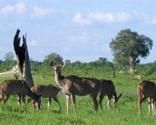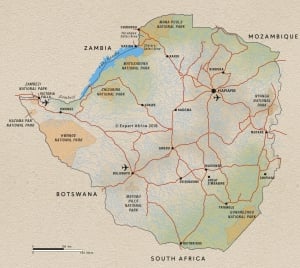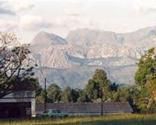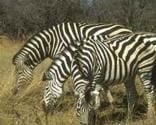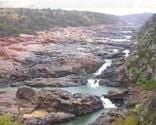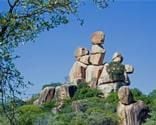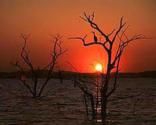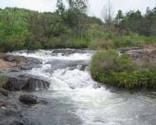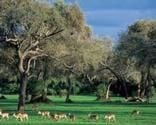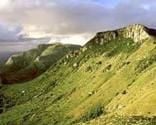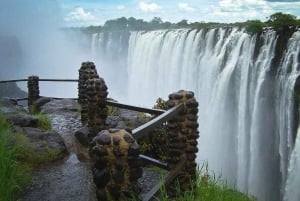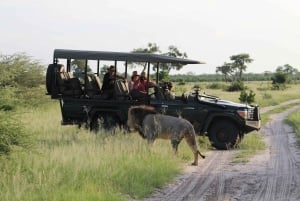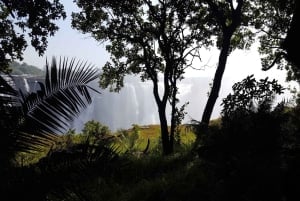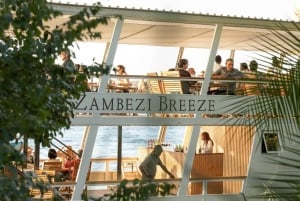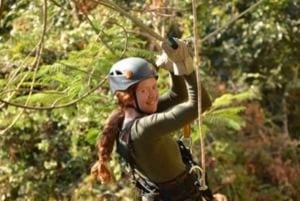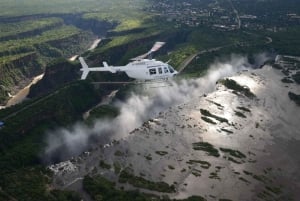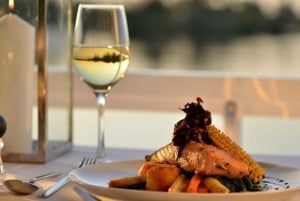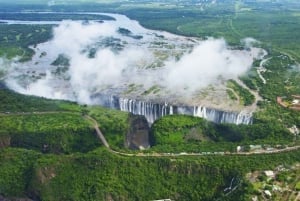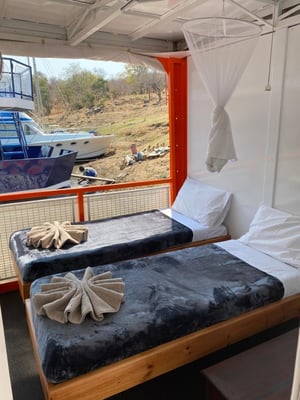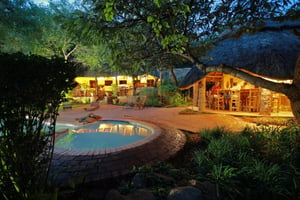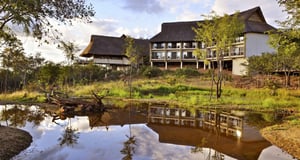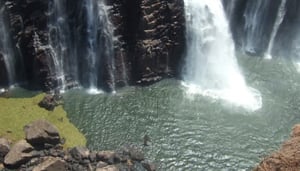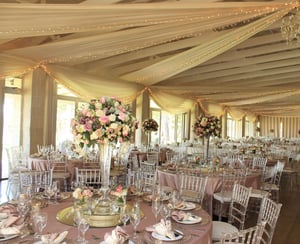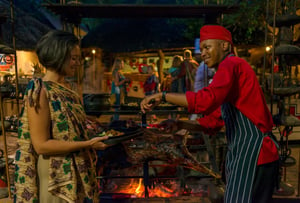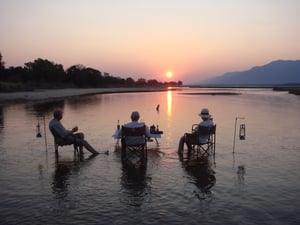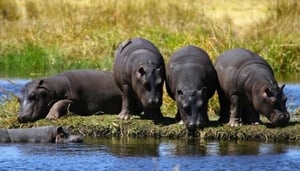Zimbabwe's National Parks
11 national parks across the country
Hwange National Park
Hwange is one of the wildest parks in Africa and the largest wildlife park in Zimbabwe. It is home to large herds of elephants, buffalos, antelopes and also has plenty of predators such as leopards, lions, hyenas, jackals and wild dogs The best time to visit Hwange is between August and October when it is dry and the animals come to the many waterholes in the Park.
The main camp is a central location to the park and hosts several campsites, lodges, and chalets. The main camp is one of the sites within the camp but it is more popular because there is a huge variety of game to be found there. The other camps are Robbins and Sinamatella. because the camps are far apart visitors can refuel, refresh or restock on provisions in the little shops and stopovers found within the park. Each camping site has water, braai facilities, and communal ablution blocks.
The lodges within the park have one or two bedrooms, a verandah and well-equipped kitchen, and cottages, which have a communal dining area with refrigerators, but no cutlery is provided. Chalets have one or two bedrooms and verandah, cooking facilities and make use of a communal ablution block.
Sinamatella Camp lies within a protected area for the black and white rhino, in addition to these elephants, wild dogs, lions, hippos and crocodiles can be seen. It is a good 120kms from Main Camp. There are many beautiful game viewing hides such as Manduvu Dam, Masumu Dam, Detema Dam, other activities visitors can enjoy include, wilderness trails, walks, and fishing.
Chimanimani National Park
The Chimanimani National Park is a gem found in the Eastern highlands of Zimbabwe. A place of rolling hills, amazing mountain peaks, refreshing natural pools, waterfalls, and fresh mountain air. The park offers places of interest like the Bridal Veil Falls, Tessaâs Pool and the stunning mountains. Campsites can be found within the park, which gives visitors access to breath-taking views.
Chimanimani offers a variety of activities for adventure seekers, including hiking, birding, cave exploring and swimming in the clear pools and rivers such as Muhohwa and at the Bridal Veil Falls. For the mountain climbers, Mount Binga will be a challenge but well worth it in the end to see spectacular views.
Chizarira National Park
This park is found at the top of the Zambezi Escarpment in the northwest of Zimbabwe; it has stunning views of the Zambezi Valley and has plenty of wildlife including leopards, lions, and elephants.
Gonarezhou National Park
Gonarezhou National Park is found in the southeastern part of the country, the Save and Runde Rivers run through the park and this is where the majority of the game can be found.
Matobo National Park
Matobo National Park is situated outside Bulawayo, the second largest town in Zimbabwe. It is a protected area of the black and white rhino which is an endangered species. This park has a wide variety of animals including zebras, giraffe, leopard and many kinds of antelopes.
Matobo national park has 6 campsites where guests can find accommodation facilities. Maleme Rest camp is the largest. At Maleme there are several Lodges available, Fish Eagle and Black Eagle each have 5 beds, fully equipped kitchen and bathroom. Imbila is the most exclusive lodge which has two bedrooms and two bathrooms, a veranda which overlooks the river, and a fully equipped kitchen.
There are five single bedroom chalets and one two-bedroom chalets all with communal kitchen and ablution facilities. There are other camping sites within the park. Each one has braai facilities and communal ablution blocks. These are located close to the dams found within the Park namely Maleme Dam, Mthselele Dam, Toghwana Dam, Mesilume Dam, and Arboretum. There is also a conference facility within the park, Rhodes Hall which has a capacity of 30 people.
Activities on offer include escorted walks, game drives, fishing, tours of the historical sites which have impressive rock paintings, bird watching, and hiking.
Matusadona National Park
Matusadona National Park is an Intensive Protection Zone for black rhino and hunting is not allowed in this area. It borders Lake Kariba, attracting animals with its water and grassy banks where the lion, buffalo, elephant, waterbuck, zebra, impala, and hippos can be seen.
There are several developed camping sites that are dotted around the park and others which are secluded and more rugged. There are two major camps, Tashinga and Sanyati have modern ablution facilities complete with showers, baths, and hot water as well as braai areas. Sanyati has 6 sites in total. In addition to those, there are some exclusive camps, some of which only cater for one party at a time with a maximum of five people. One of them at Maronga is situated on the escarpment.
The undeveloped camps Jenje and Kanjedza are in rugged terrain and visitors are advised that they are only accessible with four-wheel drive vehicles. For those who do not like camping alternative accommodation can be found at Ume and Mbalabala Lodges which are found close to the Tashinga airstrip
Matusadona has plenty of birdlife as well as wildlife, and activities include bird watching in the stunning Sanyati Gorge, game drives, hiking, and escarpment climbing as well as fishing in rivers that enter the lake Kariba
Chizarira National Park
Chizarira is a remote game park located in the northern region of Zimbabwe. It is not popular but is well endowed with various animal species. With three rivers running through it (Mcheni, Busi, and Lwizikululu) the park also boasts of a variegated vegetation profile that features Mopane scrub and Acacia woodland. The area also supports various bird species including some rare ones such as the African Broadbill and the Angola Pitta.
Chizarira national park is open all year round and offers little in terms of well-developed campsites and the roads are rather rugged. Experienced guides are available for game walks
Nyanga National Park
The Nyanga National park is located in the Eastern highlands of Zimbabwe. A place of rolling hills, amazing mountain peaks, rivers, waterfalls, and fresh mountain air. All the accommodation facilities offered in the park gives visitors access to breath-taking views.
There are beautiful thatched lodges located at the three dams within the park namely Mare, Rhodes and Udu dams. They all have good self-catering facilities all self-contained with refrigerator, stove and cooking utensils.
Campsites can be found on the Nyangombe river, and at Mare. This particular site has plenty of acacia trees to give campers shelter.
Nyanga offers a variety of activities for adventure seekers, including visiting and swimming in the Falls and rivers such as Nyangombe, Mutarazi, Pungwe Gorge and, Nyamuziwa Falls. For the mountain climbers, Mount Inyangani will be a challenge but absolutely gorgeous as you will see spectacular views. Other activities on offer are horse riding along forest trails, fly fishing and golf.
Mana Pools National Park
Mana Pools is one of Zimbabweâs vast wildlife parks which offers picturesque wilderness beauty and boasts of abundant wildlife. The park offers various accommodation options for its guests and campers stay right in the midst of this wildlife and nature. The Nyamepi camping area is a large communal camping site, in total it has 30 sites and is situated along the Zambezi River. Campers need to bring all their own camping equipment, there are ablution blocks with hot and cold water, as well as a braai area. Firewood is available at the Mana Pools Reception office which is not far from the camping ground.
For people who want to get away from it all there are some exclusive camps also found along the Zambezi River, namely Mucheni, Nkupe, Ndungu, New Ngundu, and Gwaya. The only facilities available at these camps are a braai stand at each site and a toilet, water has to be collected from the office or the river. These camps take a maximum of twelve people and two vehicles per stay.
Another option available is to try out the wild exclusive camps called Chitake Camp 1 (Nzou) and Chitake Camp 2 (Shumba). These two camps are found in the southern part of the Park close to Chitake Spring close to the bottom of the Zambezi Escarpment. Visitors check-in for these camps at the Nyakasikana Gate. No facilities at all are provided at these camps, and only four-wheel-drive vehicles can access these campsites. Enjoy relaxing and watching the variety of game which is plentiful in the park, or take part in the many activities on offer such as fishing, lion tracking, and canoeing.
Zambezi National Park
Victoria Falls is the most sought after tourist destination in Zimbabwe. It is a major attraction located within the Zambezi National Park. The Park provides visitors with a choice of places to stay as they enjoy discovering Victoria Falls. Activities in the area include game viewing, fishing, boat cruises on the Zambezi River, and moonlight viewing.
The lodges are self-contained and found on the banks of the Zambezi River, they are open all year round and they have a self-catering facility Each lodge has two bedrooms, living room, bathroom, and kitchen.
For those who love fishing, there are three exclusive fishing camps Kandahari, Siansimba, and Mpala Jena as well which is situated on the banks of the Zambezi River. These camps have showers, toilets, and braai facilities. Fishing by boat is very good in these areas.
There are four bush camps also found on the banks of the Zambezi, these are underdeveloped, thus they are not fenced off and are perfect for those who want to be out in the wilderness. These camps only have braai facilities and bush toilets. Each camp can accommodate up to twelve people and are positioned on a particularly beautiful part of the Zambezi River.
Bvumba Botanical Gardens National Park
Vumba is located 25 kilometers out of the city of Mutare. An evergreen paradise which is made up of many picturesque views, its meandering road overlooks the stunning Burma Valley and neighboring Mozambique. The Bvumba mountains, from whence Vumba gets its name sits on the Zim-Mozambique border and give the rise to wonderful mist capped views particularly in the mornings.
Vumba National Park is an area endowed with various plant and flower species such as proteas, orchids, azaleas, ferns, and other indigenous tree species. The park as it is today is divided into two, the botanical reserve and the botanical Gardens. With a combined acreage of 201 Hectares which until the early â70s was private property.





